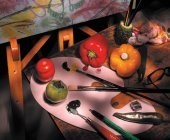|
Lens FlareLens flare is created when unwanted light is reflected back within the lens body. This internal reflection reduces the contrast of the image and a bright spot is created within the image. The magnitude of flare is multiplied, when we shoot a subject against light. This is a lens fault, which can be corrected with number of steps and precautions. A good lens hood, which has a rich dull black internal surface, will cut off most of the unwanted light, which causes a flare. However, if the lens body is not well designed, it will cause internal reflections from its barrel wall. Most of good camera lenses are designed to take care of this problem.
Flare is also caused by reflection of light from the lens itself. Multi-element lens will face more problem as each element of the lens is reflecting the light back. To correct this fault, the lens is coated with a chemical. The principle is to create a second reflection from the lens surface, which interfere with the original reflection. The result is cancellation of the original reflection, and it is termed as destructive interference.
Multi-element lens, with different glass material faces another problem. Each different glass material has slightly different refractive index. So the lens is multi-coated with slightly different thickness of the chemical and the problem of lens flare is minimized.
Prime or fix focused lens has fewer lens elements as compared to a zoom lens, therefore they perform better for flare. However, a good quality of lens coating, along with good lens barrel design will almost get rid of this lens fault. On our part, we should take care of blocking the light by using a good lens hood. To maximize the result, the main light (sun light) should be blocked with our hand or other opaque obstruction. Read about these lens faults in detail: Blur or defocus of lens: Blurring of an image due to lens fault Chromatic aberration: How chromatic aberration or distortion affects the image quality Diffraction: Scattering of light causing diffraction in an image Field curvature: Field curvature aberration of a lens Loss of contrast: How ability of capturing contrast of a lens is lost Optical distortion: Physics of optical distortion and how to check it Spherical aberration: Optics of spherical and asherical lens
Return back to Camera Lens from lens flare
|








